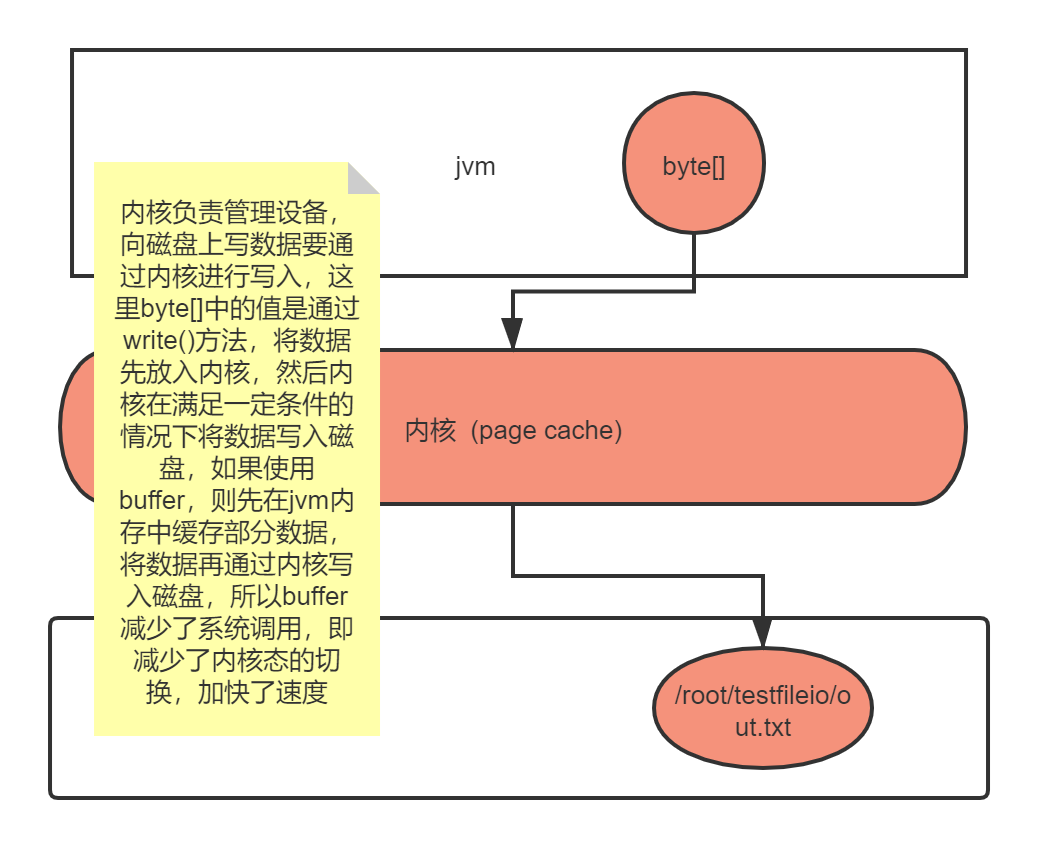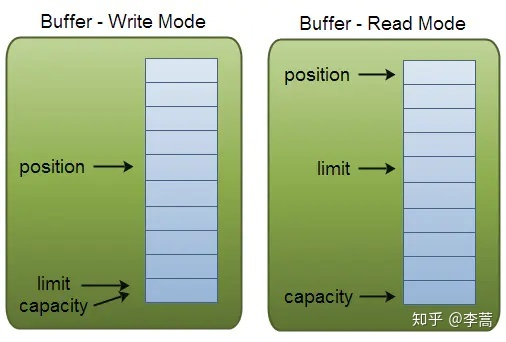IO模型
推荐博客:Java NIO:浅析I/O模型
1.寻常io
寻常io写入:
public static void testBasicFileIO() throws Exception { byte[] data = "123456789\n".getBytes(); String path = "/root/testfileio/out.txt"; File file = new File(path); FileOutputStream out = new FileOutputStream(file); out.write(data); }
寻常io缓存写入:
public static void testBufferedFileIO() throws Exception { byte[] data = "123456789\n".getBytes(); String path = "/root/testfileio/out.txt"; File file = new File(path); BufferedOutputStream out = new BufferedOutputStream(new FileOutputStream(file)); while(true){ Thread.sleep(10); out.write(data); } }
这两种写入方式的区别在于第二种使用了Buffered缓存,首先io写入模型如下:

这种写法的缺点,只能按照顺序读取数据,即当文件读取到某个位置时,只能从头再读或者继续向下读取,且该读取方式为同步阻塞
2.NIO 新的io
传统io是面向流的,nio是面向块的 a.容量(capacity) b.界限(limit) c.位置(position),缓冲区本质上是一个可以写入数据的内存块,然后可以再次读取,该对象提供了一组方法,可以更轻松地使用内存块,使用缓冲区读取和写入数据 通常遵循以下四个步骤:
1. 写数据到缓冲区;
2. 调用buffer.flip()方法;
3. 从缓冲区中读取数据;
4. 调用buffer.clear()或buffer.compat()方法;
当向buffer写入数据时,buffer会记录下写了多少数据,一旦要读取数据,需要通过flip()方法将Buffer从写模式切换到读模式,在读模式下可以读取之前写入到buffer的所有数据,一旦读完了所有的数据,就需要清空缓冲区,让它可以再次被写入。

/**创建byte缓存*/ ByteBuffer byteBuffer=ByteBuffer.allocate(20); // ByteBuffer allocateDirect=ByteBuffer.allocateDirect(1024);堆外分配 /**创建byte[],用于put,当大小大于上面创建的bytebuffer时,报BufferOverflowException*/ byte [] bytes={'q','w','e','r','t','1','2',3,4,5,6,7,8,9}; /**打印指针,当为null时,指针指向0的位置*/ System.out.println("position = " + byteBuffer.position()); System.out.println(byteBuffer); /**将bytes放入ByteBuffer*/ System.out.println("put = " + byteBuffer.put(bytes)); byteBuffer.get(); System.out.println("get = "+byteBuffer); byteBuffer.flip(); System.out.println("flip = " + byteBuffer); byteBuffer.compact(); System.out.println("compact = " + byteBuffer); System.out.println("isDirect = " + byteBuffer.isDirect());
输出:
position = 0 java.nio.HeapByteBuffer[pos=0 lim=20 cap=20] put = java.nio.HeapByteBuffer[pos=14 lim=20 cap=20] get = java.nio.HeapByteBuffer[pos=15 lim=20 cap=20] flip = java.nio.HeapByteBuffer[pos=0 lim=15 cap=20] compact = java.nio.HeapByteBuffer[pos=15 lim=20 cap=20] isDirect = false
调用get和put方法会将position向后移动,调用flip方法,position移植到0,limit移植到之前position位置,做了一次读写交换,调用compact将position移动到之前有值最大位置,limit移动到capacity位置
/** * 一、缓冲区(Buffer):在java NIO中负责数据的存取。缓冲区就是数组。用于存储 * 不同数据类型的数据 * * 根据数据类型的不同(boolean除外),提供对应类型的缓冲区: * ByteBuffer - 最常用的 * CharBuffer * ShortBuffer * IntBuffer * LongBuffer * FloatBuffer * DoubleBuffer * * 上述的缓冲区的管理方式几乎是一致的 ,通过allocate()获取缓冲区 * * 二、缓冲区里面的存取数据的两个核心方法: * put():存入数据到缓冲区中 * get():获取缓冲区中的数据 * * 四 、缓冲区中的核心属性 * capacity:容量,表示缓冲区中最大存储数据的容量,一旦声明了则不能改变。 * limit:表示缓冲区中可以操作数据的大小。(limit后数据是不可以进行读写的) * position:位置,表示缓冲区正在操作数据的位置。 * mark:标记,表示记录当前position的位置,可以通过reset()恢复到mark的位置 * * 0 <= mark <= position <= limit <= capacity */ public class TestBuffer { @Test public void test2() { String str = "abcde"; ByteBuffer buf = ByteBuffer.allocate(1024); buf.put(str.getBytes()); buf.flip(); byte[] dst = new byte[buf.limit()]; buf.get(dst,0,2); System.out.println(new String(dst, 0, 2)); System.out.println(buf.position()); //mark():标记 buf.mark(); buf.get(dst,2,2); System.out.println(new String(dst,2,2)); System.out.println(buf.position()); //reset() buf.reset(); System.out.println(buf.position()); //判断缓冲区中是否还有剩余数据 if (buf.hasRemaining()) { //如果有的话,那么获取缓冲区中可以操作的数量 System.out.println(buf.remaining()); } } @Test public void test1() { String str = "abcde"; //1.分配一个指定大小的缓冲区 ByteBuffer buf = ByteBuffer.allocate(1024); System.out.println("-------allocate()-------"); System.out.println("正在操作的位置 "+buf.position()); System.out.println("缓冲区中可操作数据的大小 "+buf.limit()); System.out.println("容量 "+buf.capacity()); //2.利用put()方法存入数据到缓冲区 buf.put(str.getBytes()); System.out.println("-------put()-------"); System.out.println("正在操作的位置 "+buf.position()); System.out.println("缓冲区中可操作数据的大小 "+buf.limit()); System.out.println("容量 "+buf.capacity()); //3.切换成读取数据的模式,利用flip()方法来进行读取数据 buf.flip(); System.out.println("-------flip()-------"); System.out.println("正在操作的位置 "+buf.position()); System.out.println("缓冲区中可操作数据的大小 "+buf.limit()); System.out.println("容量 "+buf.capacity()); //4.利用get()读取缓冲区中的数据 byte[] dst = new byte[buf.limit()]; buf.get(dst); System.out.println(new String(dst,0,dst.length)); System.out.println("-------get()-------"); System.out.println("正在操作的位置 "+buf.position()); System.out.println("缓冲区中可操作数据的大小 "+buf.limit()); System.out.println("容量 "+buf.capacity()); //5.rewind():表示可以重复读取 buf.rewind(); System.out.println("-------rewind()-------"); System.out.println("正在操作的位置 "+buf.position()); System.out.println("缓冲区中可操作数据的大小 "+buf.limit()); System.out.println("容量 "+buf.capacity()); //6.清空缓冲区,但是缓冲区中的数据依然存在,只不过数据是处于被遗望的状态 buf.clear(); System.out.println("-------clear()-------"); System.out.println("正在操作的位置 "+buf.position()); System.out.println("缓冲区中可操作数据的大小 "+buf.limit()); System.out.println("容量 "+buf.capacity()); System.out.println((char)buf.get()); } } 原文链接:https://blog.csdn.net/weixin_37778801/article/details/86699341
一、通道(Channel):用于源节点和目标节点的连接。在Java nio中负责缓冲区中数据的传输。
Channel本身不存储数据,因此需要配合缓冲区进行传输。
二、通道的主要实现类
java.nio.channels.Channel 接口
|--FileChannel
|--SocketChannel
|--ServerSocketChannel
|--DatagramChannel
三、获取通道
1.Java针对支持通道的类提供了getChannel()方法
本地IO:
FileInputStream、FileOutputStream
RandomAccessFile
网络IO:
Socket
ServerSocket
DatagramSocket
2、在JDK1.7中的NIO.2针对各个通道提供了静态方法open()
3、在JDK1.7中的NIO.2的File工具类的newByteChannel()
public class TestChannel { //1.利用通道来完成文件的复制 @Test public void test1() { FileInputStream fis = null; FileOutputStream fos = null; FileChannel inChannel = null; FileChannel outChannel = null; try { fis = new FileInputStream("1.jpg"); fos = new FileOutputStream("3.jpg"); //2.获取通道 inChannel = fis.getChannel(); outChannel = fos.getChannel(); //3.分配一个指定大小的缓冲区 ByteBuffer buf = ByteBuffer.allocate(1024); //4.将通道中的数据存入缓冲区中读取数据 while (inChannel.read(buf) != -1) { buf.flip();//切换成读取数据的模式 //5.将缓冲区中的数据再写入到通道 outChannel.write(buf); //清空缓冲区 buf.clear(); } } catch (IOException e) { e.printStackTrace(); }finally { if ( outChannel != null) { try { outChannel.close(); } catch (IOException e) { e.printStackTrace(); } } if (inChannel!=null) { try { inChannel.close(); } catch (IOException e) { e.printStackTrace(); } } if (fos!=null) { try { fos.close(); } catch (IOException e) { e.printStackTrace(); } } if (fis!=null) { try { fis.close(); } catch (IOException e) { e.printStackTrace(); } } } } } 原文链接:https://blog.csdn.net/weixin_37778801/article/details/86699341
//2.使用直接缓冲区完成文件的复制(内存映射文件的方式) @Test public void test2() throws IOException { long start = System.currentTimeMillis(); FileChannel inChannel = FileChannel.open(Paths.get("1.jpg"), StandardOpenOption.READ); FileChannel outChannel = FileChannel.open(Paths.get("8.jpg"), StandardOpenOption.WRITE,StandardOpenOption.READ,StandardOpenOption.CREATE_NEW); //内存映射文件 MappedByteBuffer inMappedBuf = inChannel.map(MapMode.READ_ONLY, 0, inChannel.size()); MappedByteBuffer outMappedBuf = outChannel.map(MapMode.READ_WRITE, 0, inChannel.size()); //直接对缓冲区进行数据的读写操作 byte[] dst = new byte[inMappedBuf.limit()]; inMappedBuf.get(dst); outMappedBuf.put(dst); inChannel.close(); outChannel.close(); long end = System.currentTimeMillis(); System.out.println("内存映射文件所花时间:"+(end-start)); }



 浙公网安备 33010602011771号
浙公网安备 33010602011771号